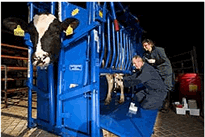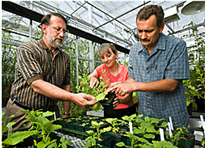



Plant-Produced Protein Eases Dairy Cow Infection
By Rosalie Marion Bliss, United States Department of Agriculture, Agricultural Research Service. ARS researchers have developed a new approach to thwart bacteria that cause coliform mastitis, an inflammatory udder disease of dairy cows. |
| Low-temperature electron micrograph of a cluster of E. coli bacteria, which can cause mastitis in cows. Each individual bacterium is oblong shaped. |
Coliform mastitis is the most prevalent form of clinical mastitis in the dairy industry and is mainly caused by the Escherichia coli bacterium. Use of antibiotics to control mastitis infections can be expensive and carries with it concerns about the emergence of antibiotic-resistant bacteria. Yet mastitis is expensive too, costing dairy farmers an estimated $2 billion annually from incapacitated cows and milk that can’t be sold.
Now, ARS molecular biologist Lev Nemchinov and plant pathologist Rosemarie Hammond have endowed a potato virus with a gene that—when introduced into a host plant—prompts the plant to produce a therapeutic protein called “CD14.” First isolated by Dante Zarlenga of the ARS Bovine Functional Genomics Laboratory, this beneficial protein can be extracted from the plant and used to treat mastitis.
Nemchinov and Hammond are with the Molecular Plant Pathology Laboratory at Beltsville, Maryland. Their engineered, or recombinant, virus is called “PVX/CD14,” for “potato virus X carrying the gene of therapeutic protein CD14.”
Protein Power
 |
| Microbiologist Doug Bannerman and visiting graduate student Manuela Rinaldi collect milk samples from a cow with mastitis. The cow was treated with CD14 derived from tobacco plants. |
The researchers extracted enough CD14 protein from the inoculated plants for field tests. Their colleagues, dairy scientist Max Paape and microbiologist Douglas Bannerman with the ARS Bovine Functional Genomics Laboratory, Beltsville, Maryland, tested the purified protein’s ability to alleviate mastitis in dairy cows.
CD14 is known to help the immune system fight infection, but it is present in the cow’s mammary gland at low levels. CD14 binds to a molecule known as “lipopolysaccharide,” located on E. coli’s outer membrane. The scientists hypothesized that increasing the level of CD14 in the milk would enhance protection.
“When inserted into the mammary gland through the opening of a cow’s teats, CD14 binds to the E. coli and triggers the cow’s immune response, which fights mastitis inflammation,” says Hammond. “That process helps to neutralize and clear toxins produced by the bacteria, lessening the chances of an excessive immune response.”
The researchers infused the CD14 protein into one of a test cow’s four teats, or “quarters.” All four quarters were subsequently exposed to E. coli. Fewer viable bacteria were recovered from the quarter that received the CD14 treatment than from those that did not receive the plant-derived protein.
A Top-Notch Protein Factory
 |
| Plant pathologist Rosemarie Hammond and molecular biologist Lev Nemchinov (right) point out virus symptoms on plants containing the CD14 gene to molecular biologist Dante Zarlenga. |
The researchers chose tobacco plants, Nicotiana benthamiana, to be their CD14-producing factories. “We inoculated the young plants with laboratory-produced RNA of our recombinant virus by rubbing a small drop of the RNA onto the plants’ leaves.”
Once the viral RNA enters the test plants through small tears in the leaves, it begins to spread and the CD14 gene begins to make the protein. The protein can then be extracted from mashed-up leaves.
Hammond says this is the first report of a functionally active animal receptor protein being produced in a plant.
When a plant is infected with a virus, thousands of copies of viral RNA are made in each plant cell. “When our recombinant virus reproduces itself in a plant cell, it also makes the target protein, CD14. This is how the virus turns a plant into a bio-factory that rapidly generates proteins of interest,” says Nemchinov. Separating and extracting the therapeutic protein from the host plant is possible because Nemchinov first tagged the CD14 protein with the amino acid histidine. “The histamine-tag tracker enables us to harvest high levels of the desired plant-produced protein,” he says.
The researchers are able to purify about 1,000 micrograms of CD14 from 10 grams of leaf tissue taken from one plant. That means each of these plants provides enough protein to potentially treat about 10 cows with a dosage of 100 micrograms each. Fifty plants would yield purified protein to treat a herd of 500 cows.
One large greenhouse can accommodate enough host plants for large-scale purification of therapeutic protein. Another advantage of the greenhouse approach is that the plants inoculated with laboratory-derived infectious RNA could be used to inoculate more plants to scale-up protein production.
Partnering for Further Development
ARS has applied for patent protection on the plant-derived CD14, and the researchers are now seeking partners to help further develop and test the protein for safety, effectiveness, and proper dosage.The CD14-based product may eventually be commercially developed for use by dairy farmers as a treatment to prevent cows from becoming infected during their dry period. Dairy cows are milked for 305 days and then enter a 60-day dry period, during which they are most susceptible to coliform infections. The plant-made CD14 could be incorporated into a polymer and infused into the udder during dry-off. The polymer would allow slow release throughout the dry period to help fight infections.
“As a next step, we’d like to work with a commercial partner to produce large volumes of plant-made CD14 and then conduct further tests to determine the most effective dosages in cows to achieve maximal protection from infection,” says Hammond. “We may not need as much as the 100 micrograms per dose that we used in our first tests. Further studies may show that we can achieve the same results with less protein.”
A paper describing the work appeared in the July 2006 issue of The FASEB Journal.
By expressing an easily purified therapeutic protein in plants, the ARS team has developed a novel preventive approach to treating mastitis that may provide a cost-effective alternative to antibiotic use.
November 2007


